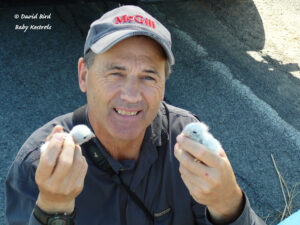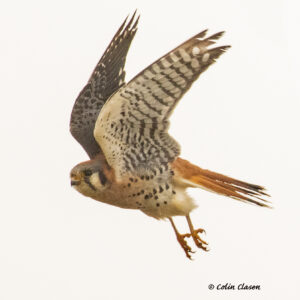The American Kestrel – from common to scarce
THE AMERICAN KESTREL
From Common to Scarce
Dr. David M. Bird is an Emeritus Professor of Wildlife Biology of McGill University in Montreal, Quebec. He and his graduate students have been studying American Kestrels since 1973, both in the field and in captivity, during which time they have bred several thousand kestrels. He has published close to 200 peer-reviewed scientific papers and supervised 50 graduate students on a wide range of wildlife themes, mostly on birds of prey and in more recent years, the application of drones to wildlife research and conservation. Until his retirement to Vancouver Island in 2013, he taught several university-level courses, including ornithology, wildlife conservation, animal behaviour and scientific/public communication. He has written and/or edited more than a dozen books, the most recent ones being the third edition of Birds of Canada, the second edition of Pocket Birds of Canada, and The Canada Jay – A National Bird for Canada?. Besides his innumerable public lectures and radio, television and newspaper appearances, Dr. Bird is a regular columnist/contributor on birds for two magazines and does a biweekly video blog for Brome Bird News. He is currently heading a national team to establish the Canada Jay as Canada’s national bird.
Peruse any popular book or booklet on North American birds of prey written twenty years ago and you are apt to read the words “widespread and numerous” or “most common” as descriptors for the American Kestrel. In his 1982 book, The Falcons of the World, Tom Cade estimated there to be more than 1.2 million pairs of kestrels breeding in North America. Now, over 30 years later, it would be interesting to know whether such an estimate would still be accurate. Over the last four decades, many managers of long-term nest-box programs for kestrels in North America have noticed disturbing declines in not the productivity, but in the numbers of nest boxes occupied by kestrel pairs. However, not all kestrel populations seem similarly afflicted (e.g. Idaho, Oregon, New York City). There is no shortage of interesting hypotheses for the cause of the decline, which are by no means mutually exclusive. Some of the more prominent ones include predation pressure from larger raptors (e.g. Cooper’s Hawks), diseases such as West Nile virus, competition with introduced cavity-nesters like European Starlings, impacts of poisonous chemicals such as brominated flame-retardants, selenium, and rodenticides; strikes by aircraft at airports, and more subtle, widespread changes in habitats and/or invertebrate prey availability due to climate change. This presentation will provide the latest figures on population trends, assess the various hypotheses, and conclude with a discussion of what can be done and what is being done to stem the decline. One thing is for certain – based on Dr. Bird’s personal experience, American Kestrels can be easily bred in captivity for release programs. Let us hope that it does not come to that.
This presentation will be via Zoom Video Conferencing. On the Monday preceding the event, Nature Vancouver members will receive the Zoom link in the weekly e-News. The talk will begin at 7:30 pm. Non-members are welcome and should Email eNews@naturevancouver.ca a few days ahead to register for the link.

